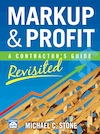A very nice gentleman called me last Friday to give me a homeowner’s view of cost-plus. He related a story about his home remodeling project. It was done as Cost-Plus job, the “plus” was negotiated at 18%.
The original estimate from his contractor to do a large, miscellaneous interior remodeling job was $87,000, and it would be done in three months or less. It was Cost-Plus because the contractor told him that was the safest way to do contracts.
On April 1 (six weeks ago), the owner sat the contractor down and said he wanted a firm price and a firm time schedule for the work to be completed. At that point, the owner had already made $125,000 in payments and the job had been going for 4-1/2 months. The contractor told him the remaining work would take about $22,000 and he would be done by May 1. In the list of job costs, the owner noticed the contractor is charging for fuel to travel to the job site. Gasoline as a job cost?
Like what you’re reading? Purchase
Markup & Profit: A Contractor’s Guide Revisited. The basics of running a profitable construction business. Softcover, eBook, and audiobook formats
Order it Here
It’s the second week in May. The job is still not done, the bills for all work since April 1 have exceeded $25,000 and the contractor says there is an additional amount of at least $15,000 to finish the job.
I can’t give legal advice but I shared a few ideas with the owner on what he should have done, and what he could and should do during the remainder of this job. It’s clear to me that either this contractor is putting the screws to this owner, or the contractor is incompetent. The owner had already told the contractor he can’t come back to the job site. But the owner is allowing one person from the company to come to the job site each day to finish up the job.
The point I want everyone to understand (building owners, contractors and architects) is that a Cost-Plus contract is no-win contract. Period, end of conversation. We’ve posted many reasons that Cost-Plus contracts are a problem on our website. We didn’t list claiming gasoline as a job cost – maybe we should add that..
The second reason listed that Cost-Plus is bad for the building owner starts with “Cost-Plus contracts give the contractor little incentive to get in and get the job done.” This contractor was very careful not to include a completion date on his contract. He was also very careful not to give the owner anything in writing when the owner requested it on April 1.
A construction company can’t operate on an 18% overhead and profit margin. That is nonsense. City, county and state fees, taxes, required licenses, insurances and permits are 6% to 9% of the price of the job all by themselves. How can a contractor pay the remaining overhead bills (like fuel) and make a profit with the balance? The truth is, they can’t. The only way to stay in business while charging an 18% overhead and profit margin is to move overhead expenses into job costs. It’s a game.
Cost-plus is the worst possible contract. Many building owners request Cost-Plus because they think the job will be done for less. Too often, the money they saved on their project gets spent in legal fees. And when a contractor suggests going the easy route and doing a Cost-Plus contract, it should be a warning sign to an owner – why do you want a contractor who cuts corners?
Cost-Plus contracts are only good for the legal profession because they get paid when the lawsuit starts. Ask for, and insist on a fully detailed contract with a fixed price that tells you exactly what you’ll get for that price. No surprises for anyone.
The knowledge and experience Michael Stone gained in his 60+ years in construction has helped thousands of contractors improve their businesses and their lives. He is the author of the books Markup & Profit Revisited, Profitable Sales, and Estimating Construction Profitably, and is available for one-on-one consultations.


 wpDiscuz
wpDiscuz